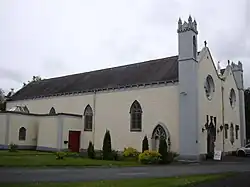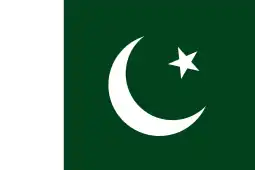Ballyhaunis
Béal Átha hAmhnais | |
|---|---|
Town | |
 Ballyhaunis Friary | |
 Ballyhaunis Location in Ireland | |
| Coordinates: 53°46′00″N 8°46′00″W / 53.7667°N 8.7667°W | |
| Country | Ireland |
| Province | Connacht |
| County | County Mayo |
| Elevation | 89 m (292 ft) |
| Population | |
| • Total | 2,366 |
| Time zone | UTC+0 (WET) |
| • Summer (DST) | UTC-1 (IST (WEST)) |
| Irish Grid Reference | M498794 |
| Website | www |
Ballyhaunis (Irish: Béal Átha hAmhnais, meaning 'ford-mouth of strife')[2][3] is a town in County Mayo, Ireland. It is at the crossroads of the N60 and N83 National secondary roads and on the railway line linking Dublin to Westport and Ballina.
It is thought that the town grew up around St Mary's Augustinian Friary (popularly referred to as "the Abbey"), which was founded in 1348, according to local tradition. The town and its hinterland contain a number of megalithic monuments.[3]
According to the 2016 Census, Ballyhaunis had a population of 2,312. Non-Irish nationals made up 42% of the population,[4] which is much higher than the national average of and is the highest of any town in Ireland.[5] Poles and Pakistanis make up the largest groups of immigrants.[4] Meanwhile, ethnic Irish people make up 40% of the population.[6]
Ballyhaunis has one of the highest proportions of Muslims in Ireland. Around 23% of the town’s population of 2,300 identifies as Muslim as of the 2016 Census.[7]
There are two Roman Catholic churches in the town, and it is also home to Ireland's first purpose-built mosque, the first mosque in Ireland outside Dublin. Farming, private business and industry are the main sources of employment.[8]
Ballyhaunis is within both the Roman Catholic and civil parishes of Annagh.[9]
History
War of Independence
On 2 August 1920, during the Irish War of Independence, the Irish Republican Army (IRA) ambushed a British Army lorry on the Claremorris road from Ballyhaunis, seizing weapons and ammunition.[10] The spot of the ambush, known as the Holywell Ambush, is marked by a high cross.
On 1 April 1921, Sean Corcoran, O/C of the IRA's East Mayo Brigade, was shot dead by British soldiers after a short gunfight at Crossard crossroads (6 km north of Ballyhaunis). A cross marks the spot where Corcoran died. Later that same day, a member of the Black and Tans was killed by the IRA in the town. In retaliation, the Black and Tans executed Michael Coen, a local man who was an IRA volunteer.[11] Coen is believed not to have taken part in any of the preceding incidents. A monument to Coen was placed on the Cloonfad/Galway road from Ballyhaunis. In May 1921, Patrick Boland, captain of the Corssard Coy, IRA, was killed by crown forces.
1990s
In 1999, Ballyhaunis was one of several locations in the European Union selected to trial a local currency project, known as the ROMA, designed to develop the local economy and ease the transition to the euro.[12]
Protected buildings
According to Mayo County Council, four buildings in the town are protected under Part IV of the Planning and Development Act 2000.[13] These include:
- St Patrick's Parish Church (a Roman Catholic church).
- The former St Joseph's Convent.
- St. Mary's Augustinian Friary.
- The Ulster Bank.
Media
MidWest Radio is based at Ballyhaunis, and is a local radio station for Counties Mayo, Galway, Roscommon, Sligo and Leitrim. Ballyhaunis also has a dedicated internet radio station, Midwest Irish Radio.
Annagh Magazine is an annual publication that appears each December, containing material of local interest. It was established by Ballyhaunis Junior Chamber in 1977, and named after the local parish. The first edition was published at Christmas 1978. It includes articles about local events over the past year, as well as contributions covering Ballyhaunis history and culture.[14][15]
Education
The town has a single primary school and secondary school; the co-educational primary school was formed by the merging of the town's original two primary schools, St Mary's Boys' National School and St Joseph's Girls' National School, to form Scoil Iosa National School.[16] Ballyhaunis Community School, as was the case with a lot of community schools, was based on the merging of three schools that previously existed independently, St. Joseph's Convent Secondary School, Ballyhaunis Vocational School, and St. Patrick's College; the school first opened in September 1977.[17]
Transport
Rail
The town has access to Ballyhaunis railway station, a station on the Dublin–Westport rail service. The station opened on 1 October 1861, and its 150th anniversary was celebrated by a Ballyhaunis Railway Station-themed edition of the local Annagh Magazine in 2011.[14][18]
Sports
Ballyhaunis GAA is the main sporting team in the town, fielding teams in both Gaelic football and hurling. Other sports played in Ballyhaunis include rugby, boxing, cricket, and soccer, and the town has three GAA pitches, two football pitches, two rugby pitches, a football astro pitch, a football and basketball court and a cricket training pitch.
Twin towns
Ballyhaunis is twinned with
 Guilers, France (1984)[19]
Guilers, France (1984)[19] Faisalabad, Pakistan (1989)
Faisalabad, Pakistan (1989)
People
- J. J. Cribbin – Gaelic footballer.[20]
- Charles Dillon – buried in the Friary with many of his ancestors. The Dillon family were Normans who developed the town from the 1200s.
- Seán Flanagan – Gaelic footballer, politician and government Minister.
- Jim Higgins – Senator, TD and Member of the European Parliament.
- Keith Higgins – full back on the senior Mayo football team.
- Anthony Jordan – author and biographer.
- Bill Naughton – playwright; wrote Alfie (1963), the basis of two film adaptations.
- Pamela Uba, Miss Ireland contest winner in 2021.[21]
References
- ↑ "Census 2016 Sapmap Area: Settlements Ballyhaunis". Central Statistics Office (Ireland). Archived from the original on 19 July 2018. Retrieved 19 July 2018.
- ↑ "Placenames Database of Ireland". Logainm.ie (in Irish). Retrieved 7 August 2018.
- 1 2 "A Very Short History of Ballyhaunis and District" (PDF). Annagh Magazine. 2008. Archived from the original (PDF) on 7 September 2012. Retrieved 7 August 2018.
- 1 2 "2011 Census Results: Ballyhaunis Area" (PDF). CSO Census. 2011.
- ↑ "The growth of intolerancee". The Irish Times. Dublin. 29 June 2013. ISSN 0791-5144.
- ↑ "'Social cohesion' of Ballyhaunis 'under threat'". The Mayo News. 1 December 2015.
- ↑ data.cso.ie https://data.cso.ie/. Retrieved 19 November 2023.
{{cite web}}: Missing or empty|title=(help) - ↑ "Ballyhaunis Local Area Plan 2010-2016 accessed through Wayback Machine" (PDF). www.mayococo.ie. 8 February 2010. Archived from the original (PDF) on 16 November 2017. Retrieved 7 August 2018.
- ↑ "Parish of Ballyhaunis". Archdiocese of Tuam. 10 December 2009. Archived from the original on 7 August 2018. Retrieved 7 August 2018.
- ↑ "Mayo history: Holywell Ambush 'backfired' on IRA volunteers". Connaught Telegraph. 9 December 2023. Retrieved 1 January 2024.
- ↑ "Chronology of Irish History 1919-1923 | April 1921". irishhistory1919-1923chronology.ie. Retrieved 1 January 2024.
- ↑ Bance, Michael (19 July 1999). "Community Currency In Action". RTÉ. Retrieved 12 August 2019.
- ↑ Mayo Co Co - Protected Structures: http://www.mayococo.ie/en/Services/Heritage/BuiltHeritage/ProtectedStructures/
- 1 2 "Annagh Magazine". Ballyhaunis Life. Archived from the original on 26 April 2012. Retrieved 7 December 2011.
- ↑ "About Us". Annagh Magazine. Archived from the original on 4 September 2011. Retrieved 7 December 2011.
- ↑ "Scoil Iosa". Ballyhaunis Life. Archived from the original on 26 April 2012. Retrieved 7 December 2011.
- ↑ School History Archived 26 April 2012 at the Wayback Machine Ballyhaunis Community School. Retrieved: 2011-12-07.
- ↑ "Ballyhaunis station" (PDF). Railscot - Irish Railways. Archived (PDF) from the original on 26 September 2007. Retrieved 6 September 2007.
- ↑ "Ballyhaunis-Guilers twinning – twenty years a-growing". Western People. 22 October 2003. Archived from the original on 15 April 2012.
- ↑ Melvin, John (8 May 2020). "Death of former Mayo footballer Fr. J.J. Cribbin". The Connaught Telegraph. Retrieved 8 May 2020.
- ↑ "Three Mayo Misses crowned with glory at Miss Ireland 2021". The Connaught Telegraph. 9 September 2021. Retrieved 9 September 2021.
External links
- Ballyhaunis entry at the Mayo Ireland website.
- Annagh Magazine — Local community, cultural, and historical magazine.
- Ballyhaunis Chamber — Local business representative organisation.
- Ballyhaunis Community Website
- Irish Rail Ballyhaunis Station Website
